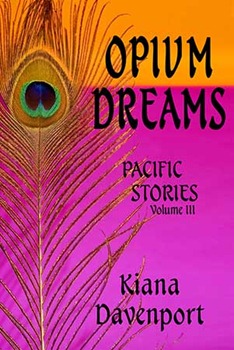OPIUM DREAMS, Pacific Stories Volume III
“And after all, what is life without one great passion, one thing to live and die for?”
It was a few days past a year ago - August 12th, 2011 to be exact – that I called CANNIBAL NIGHTS Pacific Stories, Volume II “Brutally beautiful. As noirishly dark as the deep depths of the Pacific Ocean that spawned them. (read that review here)” Opium Dreams
by comparison completes a triptych (CANNIBAL NIGHTS
, HOUSE OF SKIN PRIZE-WINNING STORIES
, and Dreams being the complete trilogy)of love, hate and acceptance, of the struggles for survival, identity, and dignity in calmer tones than the earlier two collections. If Opium Dreams was music it would be a blue saxophone on a lonely beach, in moon light with the quiet but threatening surf as accompaniment. It would be the detritus left scattered in the sand after a storm – the storm being life and the first two beautiful collections of some of the finest literary short fiction on the 21st century.
This “last panel” in the triptych consists of five stories which could stand on their own as themes to be expanded upon. They are placed in Western Samoa, Hawai’i, New Zealand, back to Hawai’i and Georgia – which sounds like a strange locale for Pacific stories, but take my word for it, it is most definitely a Pacific story. Where the two earlier volumes addressed the complexities of obsession, drug addiction, racism, erotica, loyalty, family drama, rape, prostitution, terrorism, and even murder.These delve inside the earlier themes to explore adultery, vengeance, cancer, AIDS, homophobia, and especially love in all its tragicomic manifestations. And often, combining those subjects, as an artist – and make no mistake, Davenport is an artists – would combine the different tints and hues on his or her pallet as they laid down a painting. These stories are haunting, thought provoking and educational. they will make you cry, they will make you pray. they will make you laugh and realize that you are not alone in the world. There are others that suffer and rejoice at the human journey through time and space…oh, and in enlightenment…or is that light?
Our first ‘opium dream’ is titled “Night Of The Worm (Western Samoa)” and is told by Sina, the tusitala – teller of tales in the local language. The tale is the story of Mele and Samasoni. Mele is the wife of Samasoni, the owner of a western style hotel which is defined as having toilets and electricity. It is also the tale of the night the reef gave birth. Mele is the mother of eight children and a good Samoan wife to Samsoni. Samsoni is enamored of modern, western ways and, palagi women –white women. Against a canvas of of timeless Samoan tradition meets modern western ways, where the majority of ‘palagi’ treat the islands as their own private Disneyland and encourage the islanders to avoid modernizing (it is too late, muses our narrator, “We already have heart disease, diabetes, ulcers. Still, we are a healthy, robust people. But certain palagi women come with slyness….they play with our children. Meanwhile, their bodies talk to our men.” When Samoan women act this way, when they go for married men, they pay. Palagi women must be made too pay, too.
When Pamela, a palagi tourist treats the too willing Samsoni as her private lustful tourist attraction, Mele plots her vengeance on the night of the worms, spawning a new tale of vengance and a comical, if timeless tale to be told to the children.
The second sweeping story lends its title to the entire collection and is told in beautiful prose that read like poetry. It is a story of the clash, destruction and, out of the ashes creation, of cultures and how the only culture that can ever endure is that based on love. It is a history in microcosm of rejection, exodus and return. A tale of the destruction wrought by pride and redemption built on the rock of respect, acceptance and love. A tale of beauty's betrayal and finding beauty beyond appearances.
This story will stick with you for weeks; months after the reading. If you are lucky, for a life time.
The middle tale takes us to New Zealand – Aotearoa in the Maori tongue. It is the tale of the abuse and exploitation of an ancient people by the encroachment of civilization. The tale of a mother, and a sister who are the same person, for a brother and a son who are likewise. Its moral, and plot lives by the mantra that “There is no way out. The only way is through.” It is a tale of the loss of not one but two moralities and that neither means anything, is only something you dwell on after you know where your next meal is coming from. It is a tail of familial rejection, of shame and pride dwelling in the same wickedly weak shack. And of redemption and in love, in remembrance in ka ma te, ka ma te, ka ora, ka ora – It is death, it is death. It is life. it is life.
“Bullets Over Hollywood” is a surprising change of pace, and as the stories migrate from place to place, from culture to culture and history to history, this story migrates into a modern story in feel and form. Davenport’s stories until now have been primarily tales of the abuse, decline and imminent destruction, the decay and celebration of Pacific cultures brought on by a meeting with the relentless march of western expansion disguised, often, as progress. “Bullets” is instead a thoroughly modern tale, which ironically and perhaps metaphorically is the same; the tale of westerners – haole (how-li) (when Hawaiians first encountered westerners they were so white, they thought they were ghosts, beings without breath Ha; breath. ole; without). – confronting the decay and decline of their lives through the relentless pursuit of fame and wealth and the confronting or clash of the human body when it meets disease and a reevaluation of that which is really valuable. Love. It is also a moral tale of the folly of the way we live our lives, and that like most follies, should be laughed at, not taken too seriously even if we look around after the laugh to see if anyone noticed.
The villain of the piece is not bigotry or vengeance, but cancer and the wanton embrace of what’s good to us not what’s good for us.
This brings us to the closing story in this important trilogy of literary fiction; stories that have explored, and often mugged like a thug in a dark alley, love, hate, acceptance, of the struggles for survival, identity, and dignity as old meets new and pride meets pride as prejudice. Its only fitting that all of those themes complete the cycle, not in one of the many paradises of the Pacific islands and the exotic-to-westerners lands of the Pacific rim, but in the backwoods of Georgia, in a fallen down slave quarters reclaimed from the forest. A metaphor for reclaiming human dignity? You be the judge.
“The Speed Of Light” is narrated by Bert, a white trash good old boy with such a deep seated pride in a heritage that is archaic, bigoted and ironically rooted in the economy of sucking the blood from the labor of others. Sound familiar? In the end, this tale of modern bigotry, told in surprisingly comic tones at time and in authentic “southern-ese” explores the exploitation of the strong by the weak in a place where the new ultimate sin isn’t being black but homosexual. And in the end, that hate barrier may just fall as well in the tides of enlightenment when the final lesson that is taught is that time is relative. Light is the thing. At the speed of light, time stands still. It’s the wild card. It makes things happen.
 Davenport will one day, hopefully sooner rather than later, be universally recognized as one of the greats of 21st century fiction. Her prose style is beautiful in language without resorting to beautiful language. A conundrum? Not really. She has that rare ability to make the reader experience, care deeply for and fall in love with that which they have never experienced in person. She breaks down stereotypes, prejudices and fallacies without preaching. She doesn’t leap hurdles, she removes the silly things from the path.
Davenport will one day, hopefully sooner rather than later, be universally recognized as one of the greats of 21st century fiction. Her prose style is beautiful in language without resorting to beautiful language. A conundrum? Not really. She has that rare ability to make the reader experience, care deeply for and fall in love with that which they have never experienced in person. She breaks down stereotypes, prejudices and fallacies without preaching. She doesn’t leap hurdles, she removes the silly things from the path.
Fred Astaire once said,”there is even an artful way to pick up a garbage can.” Davenport has that artful way. She could write a book of 200,000 words consisting of repeating the word “ugly’, probably in numerous dialects, and make it beautiful.
- File Size: 390 KB Print Length: 180 pages Simultaneous Device Usage: Unlimited Publisher: KIANA DAVENPORT; (1) edition (July 10, 2012)
- Sold by: Amazon Digital Services, Inc. Language: English ASIN: B008K9MBNW Text-to-Speech: Enabled
X-Ray: Not Enabled
Lending: Enabled
Article first published as Book Review: Opium Dreams: Pacific Stories Vol III by Kiana Davenport on Blogcritics.
-------------------
Copyright © 2012 Robert Carraher All Rights Reserved


No comments:
Post a Comment